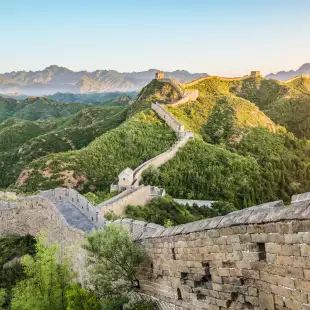China is a country of contrasts – old and new, natural and man-made, calm and chaotic
Somehow, it manages to juggle all these elements and weave together experiences that border on otherworldly. Few places manage to stay true to its cultural roots while racing towards a modern, tech-focused future, yet China balances the two with an effortless grace. A journey across its vast landscape showcases both its natural beauty and contemporary aesthetic, so you can sit back and take in every detail you can.
Holidays to China
- China
- 4* hotels
- Flights included
Watch the video
Watch the video

Popular FAQs
Beijing
The sprawling metropolis of Beijing is frequently punctuated by ancient buildings from bygone eras, ranging from small shrines to towering, ornate temples which have been carefully preserved in order to maintain a traditional presence within the city. While there’s the sense of excitement and modernity within areas like Sanlitun and 798 Art District, it’s the historical marvels where the Chinese capital truly shines. Gazing out over the waters of the expansive Summer Palace gives you an idea of the opulence the previous Emperors enjoyed. Stepping into the Forbidden City builds on this feeling, existing within the centre of Beijing within its own private grounds and creates an authentic sense of stepping back in time to the Ming and Qing dynasties.
Shanghai
While futuristic skyscrapers dominate the city’s skyline, European and classic Chinese stylistic flare can be found throughout the streets of Shanghai. There’s a persistent buzz that can be felt as you walk along the banks of the Huangpu River which sweeps through the city, with the Bund being an area of particular interest with its European-inspired architecture that lines the river’s edge. If you feel the urge to dip out of the hustle and bustle, you’ll find calm and tranquillity within the Yuyuan Gardens in Shanghai’s Old City or the Jade Buddha Temple where you can explore some of the traditional Buddhist influences on Chinese culture.
Xi'an
There’s an air of gravitas surrounding Xi’an, drawing upon its history as the former position of power within Imperial China before it was relocated to Beijing. As one of the Four Great Ancient Capitals, almost everything within its walls is steeped in China’s extensive history, from 7th century pagodas to colourful drum towers. Journeying underground will take you to the awe-inspiring Terracotta Army, comprised of over 8,000 life-size statues of Chinese soldiers which were buried with Qin Shi Huang – the first emperor of unified China – when he died. Moving through the space perfectly exemplifies the scope of this funerary art, creating a literal army of statues.
Walk on the Great Wall
Comprised of over 13,000 miles of fortifications winding their way along China’s historic borders, with some sections dating back as far as 7th-century BC, the Great Wall of China defies any and all expectations in terms of scope. Gazing out over rural China’s mountainous climes and seeing the thin line of the wall stretching all the way into the horizon hits home how immense of an architectural feat it must have been to craft something so colossal, yet so enduring.
See the Longsheng Rice Terraces
About 100 kilometres north of Guilin, these unusual, angular terraces were carved into the hills of the landscape over hundreds of years to create lush and verdant crops. These make up the picturesque Longsheng Rice Terraces, also known colloquially as the ‘Dragon’s Backbone’ due to the unique, stepped silhouette of the summit created by the terraces. Catching a glimpse of these in the morning haze, where the locals will already be hard at work, creates a perfect image of how natural beauty can combine with man-made modifications to the landscape.
Visit the Chengdu Panda Centre
Sichuan province’s capital of Chengdu is home to the world-famous Chengdu Panda Base, which carries out critical research into the conservation of giant pandas as well as raising adorable baby pandas. The enclosure where these youngsters can roam around and explore their carefully constructed surroundings is always a favourite, watching them play with their friends and get a little goofy flopping over climbing frames and slides.
In traditional Chinese culture, the standard greeting was built around it’s cuisine – ‘Chī le ma?’ (‘have you eaten?’) – as food was strongly attached to emotion and day-to-day wellbeing. Although social conventions may have changed over the centuries, the central focus on food within China hasn’t.
Hearty and honest foods like traditional dumplings (jiaozi) and stir-fried noodles (chǎo miàn) are a staple in Chinese cuisine, while more elaborate dishes like authentic Peking duck and dim sum can become a focal point for a friendly feast. You'll find there are regional specialities as you travel round, like xio long bao (dumplings filled with tasty soup) from Changzhou, persimmon cakes in Xi'an, and more.








